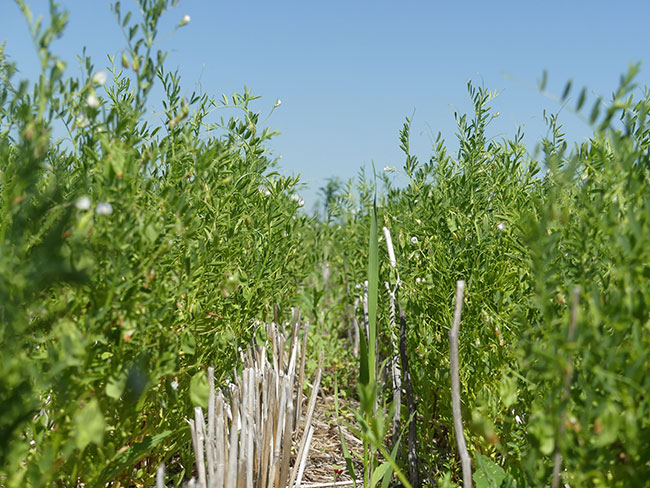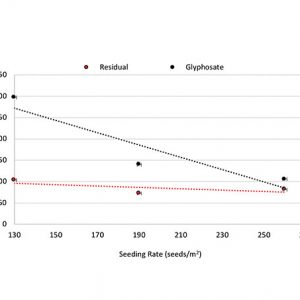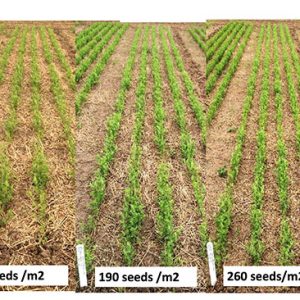
Features
Pulses
Increase seeding rates for small red lentils
Research identifies the most profitable inputs.
February 8, 2021 By Bruce Barker
 A combination of a residual pre-seed herbicide, 190 seeds/m2 seeding rate, and no fungicide in dry years
produced the highest net return. Photo by Bruce Barker.
A combination of a residual pre-seed herbicide, 190 seeds/m2 seeding rate, and no fungicide in dry years
produced the highest net return. Photo by Bruce Barker. Integrated management strategies that establish a competitive crop are the foundation of optimal yield and profitability. These include good weed control, adequate stand establishment and fungicide application when necessary.
“A major limiting factor for lentil production continues to be weed control. An effective integrated weed management practice that has been found to reduce crop-weed competition is combining herbicide applications with higher seeding rates,” says Jessica Weber of the Western Applied Research Corporation in Scott, Sask.
Weber headed up a three-year research study at five locations which looked at integrated management practices for red lentil production. The study included three seeding rates, three fungicide treatments and two herbicide management programs.
The research was conducted throughout Saskatchewan from 2017 to 2019 at locations in Scott, with the Western Applied Research Corporation; Indian Head, with Indian Head Agriculture Research Foundation; Outlook, with Irrigation Crop Diversification Corporation and Swift Current, with Wheatland Conservation Area. The study was also conducted at the East Central Research Foundation in Yorkton in 2017, then in 2018 and 2019 at the University of Saskatchewan in Saskatoon.
The herbicide management treatments compared a pre-seed burnoff of glyphosate to a pre-seed residual with a tank-mix of Focus and glyphosate. The herbicide applications were applied three-to-five days prior to seeding.
Three seeding rates of 130, 190 and 260 seeds per square metre (seeds/m2), or 13, 19 and 26 seeds per square foot, were compared. The current seeding rate recommended by Saskatchewan Pulse Growers is 130 seeds/m2. CDC Maxim small red lentil was used in the study. This lentil variety is high yielding with good resistance to ascochyta blight and anthracnose.
Three fungicide treatments included a control without fungicide application. The single fungicide application consisted of Priaxor applied at the beginning of flowering. The dual fungicide application consisted of Priaxor followed by Lance WDG 10 to 14 days after the single application.
Post-emergent herbicide applications consisted of Ares and Centurion for all treatments. Fertilizer (N-P-K-S) was applied based on soil test recommendations to achieve a 30 bushel-per-acre crop. Nodulator XL SCG lentil inoculant was applied based on label recommendations, with rates adjusted for row spacing.
All plots were direct-seeded into cereal stubble and all fertilizer was side-banded during seeding.
Crop and weed density, crop and weed dry weight biomass, disease ratings prior to fungicide application (seven, 14, and 21 days after initial application), days to flower, days to maturity, seed yield, thousand kernel weights and test weight were measured. An economic analysis was also conducted.
“Overall, it was critical to determine which integrated agronomic practices will result in the greatest productivity while remaining profitable, and if certain combinations of inputs may provide a synergistic effect to improve lentil productivity,” Weber says.
Residual herbicide reduced weed pressure
The pre-seed residual herbicide combination of Focus plus glyphosate reduced early season annual weed populations by 66 per cent, including green foxtail, cleavers, redroot pigweed, volunteer canaryseed and suppression of kochia and wild oats compared to a pre-seed burnoff of glyphosate alone.
Weber says weed growth was largely influenced by both seeding rate and herbicide application. The least effective weed management strategy was utilizing the current seeding rate recommendation of 130 seeds/m2 with glyphosate applied alone. This indicated that if pre-seed glyphosate was applied alone, the seeding rate must exceed 130 seeds/m2 to reduce weed interference.
The residual herbicide treatment was more effective than glyphosate applied alone at all three seeding rates. The most effective weed management strategy utilized a seeding rate of 190 seeds/m2 combined with a residual herbicide to reduce weed biomass by 76 per cent.
Although the residual herbicide combined with a 190 seeds/m2 seeding reduced weed biomass by 76 per cent, it ultimately had little effect on overall yields. Weber explains this is likely due to the relatively low weed densities that persisted throughout most of the locations, along with the relatively good control observed with pre-seed glyphosate and in-crop herbicides. Under weedy conditions, a yield response to residual herbicide application would be more likely to occur, especially if Group 2 or glyphosate resistance is an issue, she says.
Seeding rate influenced disease levels
Dual fungicide applications tended to have the least amount of disease pressure compared to single applications and unsprayed. Unsprayed lentil had the greatest disease pressure at 26 per cent of plant area affected, while the single and dual fungicide applications were similar with 21 and 20 per cent.
Disease severity tended to increase with seeding rate. Disease severity (prior to fungicide application) was the highest at 12 per cent at a seeding rate of 260 seeds/m2, and dropped marginally to 11 per cent at seeding rates of 190 seeds/m2 and 130 seeds/m2.
Weber explains that an important factor to consider is that CDC Maxim has good resistance to ascochyta blight and anthracnose. The combination of drought conditions in the study and relatively strong genetic disease resistance may have limited the impact of fungicide applications. High moisture, heavier soil and tight lentil rotations can increase the disease risk.
“If you are in a high-risk zone with a seeding rate exceeding 130 seeds/m2, a single fungicide may be required as a minimum. A moderate- to low-risk zone may utilize a higher seeding rate of 190 seeds/m2 with a single fungicide,” Weber says. “Utilizing 260 seeds/m2 is considered risky even under ideal conditions with dual fungicide applications.”
Highest yield with 190 seeds/m2
Seeding rate was the largest factor that influenced yield in the study. Over the combined 15 site-years, there was a significant effect of seeding rate on yield. The lowest seeding rate of 130 seeds/m2 produced a yield of 37 bushels per acre (bu/ac, or 2,516 kilograms per hectare), which was six per cent lower yield compared to the seeding rate of 190 seeds/m2. There was no significant difference between the seeding rate of 190 (40 bu/ac) and 260 seeds/m2 (39 bu/ac).
The most profitable choice is . . .
An economic analysis was conducted to determine which management strategy was the most economically feasible. On average across all treatments, the highest net return of $361 per acre ($891 per hectare) occurred with the seeding rate of 190 seeds/m2 compared to $342/ac ($845/ha) for the 130-seeds rate and $345/ac ($853) for the 260-seeds rate.
When looking at the three treatments together, the overall highest net returns occurred with a seeding rate of 190 seeds/m2, unsprayed fungicide and a residual herbicide application for a net return of $386/ac ($954/ha). The lack of a fungicide benefit wasn’t surprising since many of the site-years generally experienced drought conditions with limited disease pressure.
“While a fungicide application typically reduced net returns compared to the unsprayed, fungicides should be viewed as a form of insurance rather than an input cost, as disease management is essential for proper lentil production, especially in higher risk areas,” Weber says.

